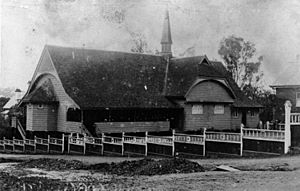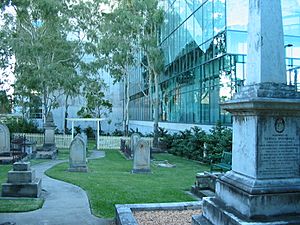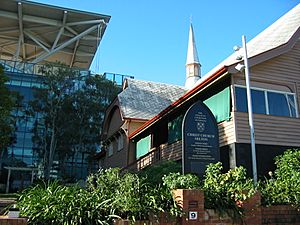Christ Church, Milton facts for kids
Quick facts for kids Christ Church, Milton |
|
|---|---|

Christ Church, with Suncorp Stadium behind, 2009
|
|
| Location | 3 Chippendall Street, Milton, City of Brisbane, Queensland, Australia |
| Design period | 1870s - 1890s (late 19th century) |
| Built | 1891 |
| Architect | John H. Buckeridge. F.D.G. Stanley |
| Official name: Christ Church, Memorial Church (former) | |
| Type | state heritage (built) |
| Designated | 21 October 1992 |
| Reference no. | 600252 |
| Significant period | 1883, 1891 (fabric) 1876 (historical) |
| Significant components | hall, stained glass window/s, grave marker, memorial - honour board/ roll of honour, furniture/fittings, pipe organ, trees/plantings, residential accommodation - rectory |
| Lua error in Module:Location_map at line 420: attempt to index field 'wikibase' (a nil value). | |
Christ Church is a historic Anglican church located at 3 Chippendall Street in Milton, Brisbane, Queensland, Australia. The church building you see today is actually the second one built on this spot. It was designed in 1891 by John H Buckeridge. Even though it was meant to be a "temporary" church, it is still used today! The rectory, which is the house for the church's priest, was built earlier in 1883. It was designed by F.D.G. Stanley. Christ Church is also known as the former Memorial Church and was added to the Queensland Heritage Register on 21 October 1992.
Contents
A Church with a Past: Christ Church History
The area where Christ Church stands in Milton includes the timber church, the rectory, and a special memorial garden. The church building was designed in 1891 by J.H. Buckeridge. It was planned to be used as both a Sunday school and a temporary church. The rectory, the priest's house, was built earlier in 1883. Its design came from F.D.G. Stanley.
Early Days and the Cemetery Connection
The church has a strong link to the Paddington Cemetery. This was Brisbane's first major burial ground. It started in the early 1840s near what is now Hale Street. The cemetery had different sections for various Christian groups and the Jewish community.
In the 1860s and early 1870s, Anglican church services were held in the cemetery's mortuary chapel. This chapel was in the Anglican part of the cemetery. In 1873, the Parish of Milton was created. It covered a much larger area than it does today. This included places like Paddington, Enoggera, Red Hill, Milton, Rosalie, and Auchenflower. Burials at the cemetery stopped in 1875.
By 1874, the church community had grown a lot. They needed a bigger, more permanent church building. Land next to the Anglican cemetery was bought. A stone church was then built. It was designed by Richard George Suter, who was a lay preacher and the church's architect. This first church was dedicated on January 16, 1876. It honored those buried in the nearby cemetery.
The church ran out of money, so the building was not fully completed as planned. The western end was finished with brick and timber. A rectory was also built for the parish priest. More land was bought near the church in 1882. A timber house in the Gothic style was built there in early 1883. F.D.G. Stanley designed this house. In 1888, the church and rectory lands were joined together. This happened when two nearby blocks were purchased.
A New Church for a Growing Community
The foundations of the first church were not strong. This meant expensive repairs were needed. A big storm in 1890 also caused a lot of damage. After the storm, it was decided to sell the church to be taken down.
A large Sunday School hall was also needed. The number of people living in the area was growing fast. In 1890, there were 250 Sunday school students. By 1900, there were 600! In the 1800s, Sunday schools were very important. They taught religion and helped shape good character.
The church community could not afford to build two separate buildings. So, they made a smart choice. The new hall was designed to also work as a temporary church.
J.H. Buckeridge designed the new church/school building. He became the church's architect in 1886. Bishop William Webber wanted many new, good quality church buildings. Buckeridge made sure even less expensive buildings looked special. Christ Church is one of his most creative designs. It cost about £920 to build. Lars Anderson, a Danish builder from Esk, built it. Anderson was known for his smart way of using light rail to get timber from hard-to-reach places.
Anderson was likely chosen because he had built St Agnes Anglican Church in Esk. That church was also designed by Buckeridge. The Milton parish priest, Rev. J. F. Leighton, had been the priest at Esk before. The quality of Anderson's work at Christ Church shows this was a good choice. The timber used came from the Esk valley. The design used the best qualities of different types of wood.
The building's first timber stumps were put in place on June 4, 1891. Bishop Webber officially opened and dedicated the building on September 18, 1891. The new church/hall was built in a different spot. This allowed the old church to be used while the new one was being built. Some items from the old church were moved over. This included a stone baptismal font. It was given to the first chapel by Andrew Petrie in 1874. Because the church had limited money, many furnishings were added later. The roof was first covered with timber shingles.
Community Life and Changes Over Time
From the start, the church served many people. This included local residents, staff, and people staying at the nearby Brisbane Gaol in Petrie Terrace. It also helped the soldiers at Victoria Barracks. The church started social groups like a men's society and a ladies' guild. It also helped the wider community. The Mother's Union group started a home nursing service. This service later became St Luke's Nursing Service.
The old cemetery grounds became run down. In 1911, the land was taken for public use. Some burials were moved to other cemeteries. But often, only the headstones were moved. From 1912-1914, over 500 headstones were moved. They went to a memorial garden within the old Anglican cemetery section. This area still had about twenty-four burials. During the Depression, most of these stones were removed and destroyed. In 1914, the Lang Park sports ground was built on the cemetery site.
Between 1905 and 1908, a timber hall was built east of the church. In 1918, changes were made. The roof shingles were replaced with asbestos cement tiles. A larger organ was also bought. This meant changes to the floor and ceiling. Other changes to the church building have been small.
The church's tall spire was damaged by a storm in 1985. It was rebuilt without the ventilation openings.
In 1987, a new road was planned. This meant a large part of the church grounds would be taken. This included part of the Memorial Reserve. The church community strongly objected, but road construction went ahead in 1989-1990. The hall was torn down. The headstones were moved again within the remaining memorial reserve. This reserve still has some early burials. It shows that this area was Brisbane's first public cemetery.
The nearby Lang Park sports ground (now Suncorp Stadium) grew bigger around 2001. This took up even more of the church's land. Because these modern buildings are so tall, the church is harder to see from the surrounding area. You can no longer get to the church from Hale Street. You can reach it from Chippendall Street.
Even though the church building was meant to be temporary, it is still used as a church today. The original timber stumps have been replaced with a low wall of concrete blocks. Modern toilets have also been built underneath.
A Look Inside: Christ Church Description
Christ Church is located at the corner of Hale and Chippendall Streets. Its spire (the tall, pointed part of the roof) is still a noticeable feature in the area. This area is now mostly light industry, not homes. However, the huge Lang Park Stadium next door really stands out. A high wall separates the church area from the Hale Street road. There's an open garden between the church and the rectory. You can get to the memorial garden through a gate in a wall from there. The church grounds still have some old, large trees.
The church is made of timber and sits on a low base of concrete blocks. It has a cruciform (cross-shaped) layout. A slender spire rises over the middle part where the arms of the cross meet. The roof is covered with diamond-shaped asbestos cement tiles. The roof's slope changes to cover the verandahs on both sides. There is a many-sided timber baptistery (where baptisms happen). The building really shows off the beauty and usefulness of Queensland timber. The outside is covered with painted weatherboards. But the outer walls of the verandahs have exposed timber studs.
Inside, the church walls are lined with unpainted pine boards. These boards have become darker with age. The roof has a special design with a crown post and scissor braces. The transepts (the "arms" of the cross shape) hold a Lady Chapel and a Warrior's Chapel. Pointed arches separate these from the nave (the main part of the church).
The windows in the main part of the church are casement windows. They have a three-leaf clover shape at the top and clear glass. But above the altar, there are seven windows with stained glass. These show Christ and saints like Paul, Mary, John, and Barnabus. The baptistery, at the southern end, has modern stained glass windows.
Some items inside the church were reused from the earlier building. This includes a stone font given by Andrew Petrie in 1874. A brass lectern (a stand for reading) was given as a memorial in 1892. The pulpit (where sermons are given) dates from 1914. The Pews (benches) in the choir and nave are carved. They add to the rich timber colors inside. There is also a timber Honour Board from World War I.
A small pipe organ by Whitehouse is to the right of the chancel (the area around the altar). It was greatly rebuilt and made electric in 1984.
The rectory is no longer used as a priest's house. However, the church uses some rooms on the enclosed verandah facing the street as offices. The main part of the house is rented out as a home. It is a single-story timber house with a steep roof. The roof is covered in corrugated iron and decorated with fretted barge boards. It sits on low stumps and has brick chimneys. A central hall leads to dining and living rooms on the left. Two bedrooms are on the right. At the back, there is a kitchen area with a scullery (a small room for washing dishes), a maid's room, and the kitchen. The house has lath and plaster walls in the main rooms. This was unusual for a house of its size. The verandah has been enclosed and made bigger over time. But the house is still mostly original. It has well-made joinery (how wood pieces are joined). Details like the arched timber front show the influence of the Gothic style.
The Memorial Reserve has 21 memorials from the old Anglican burial ground. Many of these remember members of well-known pioneer families.
Why Christ Church is Important
Christ Church Milton is important for many reasons. It helps us understand Queensland's history. Its grounds contain a part of Brisbane's first public cemetery. The church is closely linked to how Milton and Petrie Terrace grew as suburbs of Brisbane. It also helped start several other church communities. The size and quality of the church building, which was first meant as a Sunday School, show how important religious education was in Queensland in the 1800s.
The timbers used to build the church came from the Esk Valley. They are of a size and quality that are rare today. It's also uncommon to find a church, rectory, and hall so close to a graveyard in Queensland. The memorial reserve and the graves it holds are the only clear signs of Queensland's first major public cemetery.
Christ Church Milton is a great example of a Sunday School hall and church combined. Many early church communities chose this option when they didn't have much money. The wide verandahs and open space are typical of a hall. But the building also has church features like a cross-shaped floor plan, a steeple, and a baptistery. The rectory is a good, original example of a "cottage ornee" (a decorated cottage) from its time. It has a design and finish quality unusual for a house of its modest size. The memorials in the reserve show burial customs from the 1800s.
The church building is also beautiful. Its design shows features of the Arts and Crafts movement. This includes the skilled use of timber, the unique roof shape, and an elaborate roof design. The rectory is a well-made Gothic cottage. This style was probably thought to be very fitting for a church house.
Christ Church Milton also shows great creative and technical skill from its time. The way different timbers are used and how the ceiling is made shows high technical ability. The design is a clever way to combine different uses in one building. It also shows a thoughtful response to the climate with its wide verandahs and a ventilator in the steeple.
The church has a strong connection with its community. Many members have made important contributions to the wider area. It also has a special link to the work of the church's architect, J.H. Buckeridge, and Bishop William Webber. They both wanted to build strong and high-quality churches in Queensland. It is also connected to Lars Anderson, whose new methods helped the timber industry in Queensland.
Images for kids














